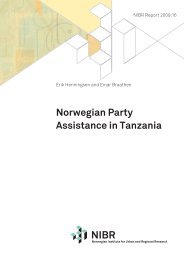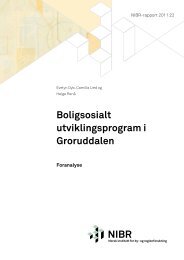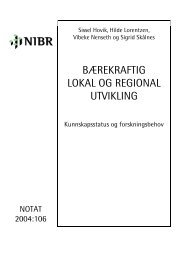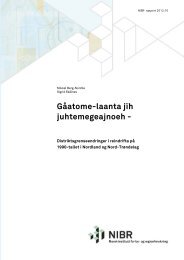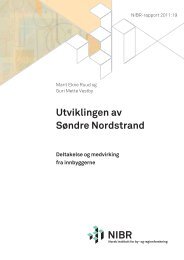http://www.tandfonline.com/page/terms-andconditions
The special importance of housing policy for ethnic minorities ...
The special importance of housing policy for ethnic minorities ...
- No tags were found...
Create successful ePaper yourself
Turn your PDF publications into a flip-book with our unique Google optimized e-Paper software.
16 H. Skifter Andersen et al.in Denmark and Sweden. However, because the population in Denmark in general livesmore seldom in overcrowded dwellings, the difference between immigrants and the wholepopulation is much greater than in Sweden. It can therefore be concluded that immigrants’housing situation, with respect to overcrowding, differs most from that of the population asa whole in Norway followed, in decreasing order, by Denmark, Finland and Sweden.Downloaded by [Norsk Institutt for By og] at 07:07 11 March 2013ConclusionsWe have shown that the housing situation of immigrants in the four Nordic countriesdiffers a great deal. It is also documented that differences in immigrants’ position in thehousing market cannot be explained by differences between the countries with respect toimmigration and general in<strong>com</strong>e inequalities alone. This indicates that elements of housingpolicies may have special effects for the housing situation of immigrants.The evidence presented in this article identifies important differences between thefour countries regarding immigrants’ distribution on tenures in the housing markets. Theanalysis shows that immigrants in Finland are most unequally distributed between tenures,measured by our index of tenure segmentation, while immigrants in Norway are the leastsegmented. Denmark and Sweden are positioned somewhere in between, with the strongestsegmentation in Denmark.Norway differs in particular by having a larger proportion of immigrants living inowner-occupied housing than in the other countries. Compared with the whole population,immigrants are less often homeowners in Finland than in Denmark and Sweden.In Denmark and Finland, a large proportion of immigrants lives in social/publichousing, while the share is very low in Norway due to its small social/publichousing sector. Compared with the whole population, Finland has the largest overrepresentationof immigrants in social/public housing, followed by Norway andDenmark which are at the same level. The lowest level of over-representation is foundin Sweden. Private renting is an important sector for immigrants in all the countries. Butimmigrants have the easiest access to private renting in Finland and Sweden. Especiallyin Denmark, immigrants do not very often live in private renting and less often livein this tenure than what would be anticipated given their lower in<strong>com</strong>es. Cooperativesare an important sector for immigrants in Sweden and Norway. This is not the case inDenmark where immigrants live less often than the average in cooperatives, and areunder-represented; especially when one considers their lower in<strong>com</strong>es.This paper shows large differences in immigrants’ housing situation measured by degreeof overcrowding. The drawback of the Norwegian housing system is that immigrants moreoften live in overcrowded dwellings than in the other countries. In Norway and Finland avery high proportion of immigrants live in overcrowded dwellings <strong>com</strong>pared with Denmarkand Sweden. But overcrowding in general differs between the countries and the picture issomewhat different if one looks at how immigrants’ housing situation differs from that ofthe whole population. The gap between immigrants and the whole population is largest inNorway. It is also quite large in Denmark and lowest in respectively Finland andSweden.If tenures are strongly divided into housing for the rich and poor, immigrants to alarge extent will be concentrated in housing for the poor. We examined whether the variationsin housing out<strong>com</strong>es for immigrants among the four countries can be explained bydifferences in in<strong>com</strong>e inequalities and in<strong>com</strong>e segmentation in the housing systems. Thehousing out<strong>com</strong>es for different in<strong>com</strong>e groups vary a great deal between the countries withrespect to segmentation and overcrowding. But, when one <strong>com</strong>pares the countries, there



